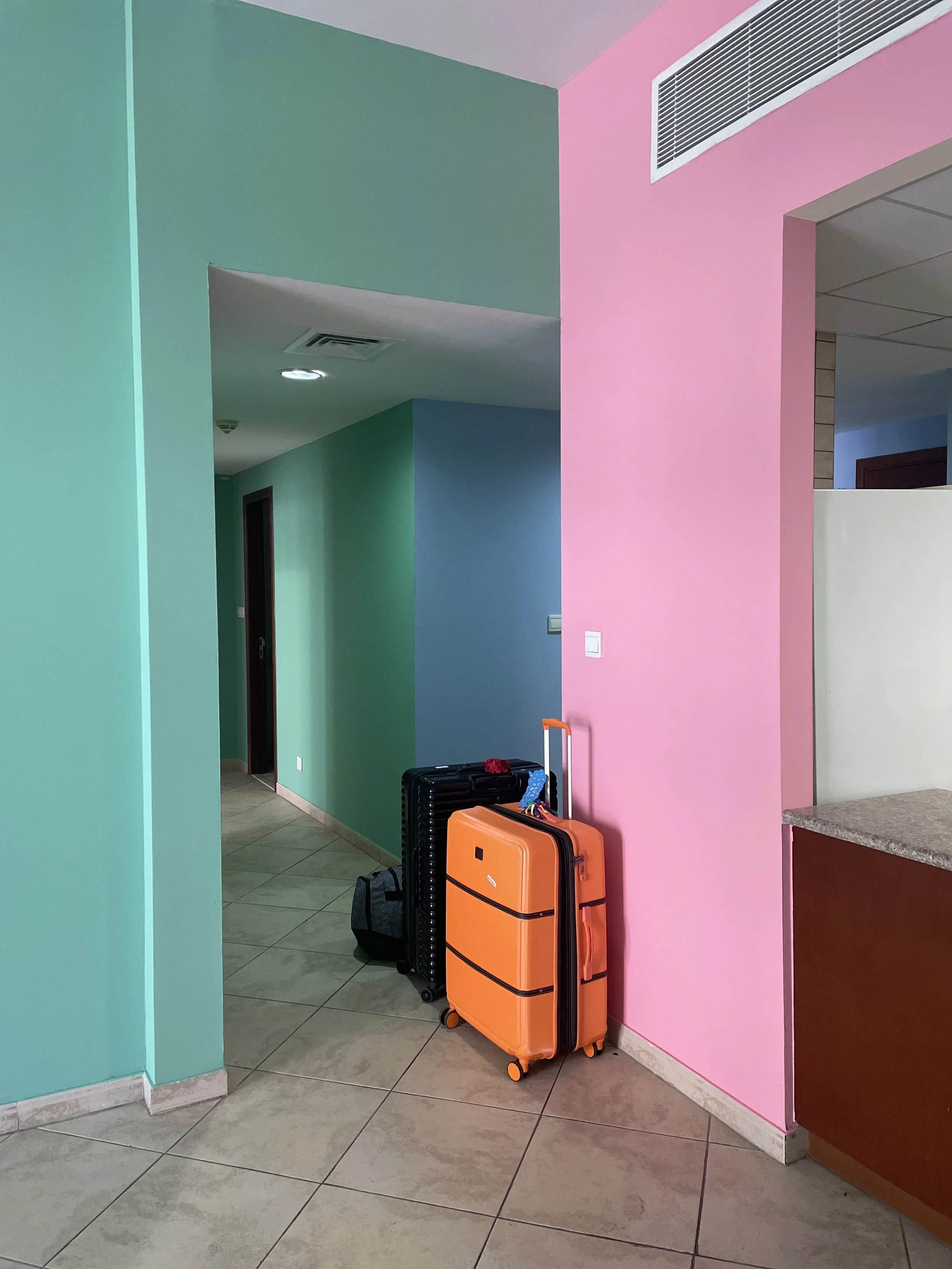Pitkästä aikaa
Long time no see.
I am writing this after what feels like a long pause: nearly one and a half years, in fact.
The last shot from my apartment in Dubai.
I really leaned into the “Pee-Wee’s Playhouse” aesthetic with the wall paint.
A few weeks ago, I came across a call from InSEA that invited member artists and educators to reflect on those intersections for an upcoming publication: looking at the inspiration, the challenges, and the ways the two identities inform one another.
This really caught my attention.
These two things have always been intrinsically linked for me: artist and educator. They are just one. However, for the first time in my career, I realised I had been sitting almost entirely in educator only mode. The pace of work, the weight of transition, and the demands of adapting to yet another country had pushed my own artistic practice to the sidelines. Survival, not creation, had been my daily rhythm for the last year.
What Cannot be Carried
After two years in Dubai, I felt a pull again to head further East. Having already lived nearly a decade this direction between South Korea and Malayisa respectively, this felt like heading home. And so, since August 2024, I started a new chapter.
And, as you can guess from the title, I found myself moving to… Beijing, China of course.
So, I am again navigating a new culture, context, and working rhythm.
Sometimes even the small things can’t fit.
Habibi stayed in Dubai.
A challenge that comes with international move is, of course, the move itself. But for artists, there is an added layer: materials, works-in-progress, and even finished pieces rarely make the journey. Kilns cannot come with you. Sculptures break. Paints are flagged in customs forms. Shipping takes week or months (in my case…5) to arrive. Sometimes the cost is just not worth the carry.
The studio (and habits) you built up in one place often vanishes in the next.
So, you begin again. That’s it.
Each move becomes not just a change of home or workplace, but a reset of your practice. And, as an artist I find myself asking: what can I do with what I have here, now?
The Silence of Survival Mode
When the school-housing agent helped me select an apartment here in Beijing, I was so pleased to have found a place with an open loft area on the second floor: good natural lighting, and sized perfectly for a home studio! Ready to go as soon as I arrived.
However, this last move was the first in which the creative reset did not come quickly for me. Instead, I found myself slipping into full teacher mode. I was absorbed by the pace of a new workplace and the sheer act of adjusting. Alongside that, much of my time outside of school was drawn elsewhere: into new rhythms, people, languages, and the kinds of shifts in life that come with both joy and loss.
For an artist whose practice is so often shaped by personal narratives, and even personal negatives, it was a strange place to land. The very themes that might have once spilled onto a canvas instead stayed unspoken, and, unformed.
My carefully selected studio space fell quiet, almost neglected. not because the inner life had stilled, but because it was pouring out in other directions.
Returning to Practice
But something shifted in the past few months. Slowly, I have been revisiting my practice, beginning with the smallest moves: buying a sketchbook and churning out some messy charcoal and pencil studies. Having mastered the art of ordering on Taobao, and I have slowly rebuilt my resources- stocking up on paints, and all the other things that I parted ways with in Dubai.
It has been a strange kind of renewal. Coming back after nearly a year feels less like resuming where I left off, and more like introducing myself again.
September musings: charcoal, graphite, acrylic markers
Teaching as a Mirror for Making
This is why the InSEA call resonated so strongly. Teaching and making have always been intertwined for me: each one deepens the other. When the making stops, the teaching feels thinner. When I return to the studio, I return with energy to bring to my students.
One of the unexpected truths I have come to recognise is how deeply my studio practice shifts alongside my teaching. In schools where I was surrounded by kilns, clay, and colleagues immersed in three-dimensional work, I found myself returning again to ceramics for the first time in university. The rhythm of working with students in those spaces rekindled my own fascination with form and material, and my hands naturally followed theirs into clay.
In other contexts, where the classroom leaned more towards painting, drawing, or printmaking, my practice bent in that direction too. The daily presence of brushes, canvases, and pigments, handled by my students, would pull me back into the two-dimensional.
It was as though the act of facilitating their creativity reignited my own, feeding back into my personal work in a continuous loop.
My students continue to create, and I should too.
A quick sketch of my Year 10 IGCSE students last year drawn during their “mock-mock” exam.
So, long time no see: to this blog, to the studio, and to myself.
And perhaps that is why the title remains in Finnish: a language that has recently carried echoes of both absence and return, reminding me how creative practice, like language, never quite leaves us. It only waits to be spoken again.



